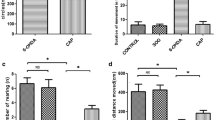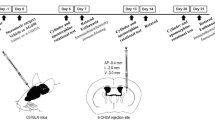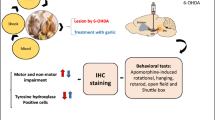Abstract
In this study, we aimed to investigate the effects of carvacrol (CA), a widely used phytochemical having anti-oxidant and neuroprotective effects, on transient receptor potential (TRP) channels in an animal model of Parkinson’s disease (PD). A total of 64 adult male Spraque-Dawley rats were divided into four groups: sham-operated, PD animal model (unilateral intrastriatal injections of 6-hydroxydopamine (6-OHDA), 6 µg/µl), PD + vehicle (dimethyl sulfoxide (DMSO)) treatment, and PD + CA treatment (10 mg/kg, every other day, for 14 days). Half of the brain samples of substantia nigra pars compacta (SNpc) and striatum (CPu) were collected for immunohistochemistry and the remaining half were used for molecular analyses. CA treatment significantly increased the density of dopaminergic neurons immunolabeled with tyrosine hydroxylase and transient receptor potential canonical 1 (TRPC1) channel in the SNpc of PD animals. In contrast, the density of astrocytes immunolabeled with glial fibrillary acetic acid and transient receptor potential ankyrin 1 (TRPA1) channel significantly decreased following CA treatment in the CPu of PD animals. RT-PCR and western blot analyses showed that 6-OHDA administration significantly reduced TRPA1 and TPRPC1 mRNA expression and protein levels in both SNpc and CPu. CA treatment significantly upregulated TRPA1 expression in PD group, while TRPC1 levels did not display an alteration. Based on this data it was concluded that CA treatment might protect the number of dopaminergic neurons by reducing the reactive astrogliosis and modulating the expression of TRP channels in both neurons and astrocytes in an animal model of PD.





Similar content being viewed by others
Availability of Data and Materials
Data available on request from the authors.
References
Balestrino R, Schapira AHV (2020) Parkinson’s disease. Eur J Neurol 27:27–42
Baluchnejadmojarad T, Hassanshahi J, Roghani M, Mansouri M, Raoufi S (2014) Protective effect of carvacrol in 6-hydroxydopamine hemiparkinsonian rat model. Journal of Basic and Clinical Pathophysiology 2:29–34
Baser KHC (2008) Biological and pharmacological activities of carvacrol and carvacrol bearing essential oils. Curr Pharm Des 14:3106–3120
Bollimuntha S, Ebadi M, Singh BB (2006) TRPC1 protects human SH-SY5Y cells against salsolinol-induced cytotoxicity by inhibiting apoptosis. Brain Res 1099(1):141–149
Chung KK, Freestone PS, Lipski J (2011) Expression and functional properties of TRPM2 channels in dopaminergic neurons of the substantia nigra of the rat. J Neurophysiol 106(6):2865–2875
Datı LM, Ulrıch H, Real CC, Feng ZP, Sun HS, Brıtto LR (2017) Carvacrol promotes neuroprotectıon in the mouse hemıparkınsonıan model. Neuroscience 356:176–181
Escartin C et al (2021) Reactive astrocyte nomenclature, definitions, and future directions. Nat Neurosci 24(3):312–325
GBD 2016 Parkinson’s Disease Collaborators (2018) Global, regional, and national burden of Parkinson’s disease, 1990–2016: a systematic analysis for the Global Burden of Disease Study 2016. Lancet Neurol 17(11):939–953
Hashimoto T, Nishi K, Nagasao J, Tsuji S, Oyanagi K (2008) Magnesium exerts both preventive and ameliorating effects in an in vitro rat Parkinson disease model involving 1-methyl-4-phenylpyridinium (MPP+) toxicity in dopaminergic neurons. Brain Res 4(1197):143–151
Hong C, Jeong B, Park HJ, Chung JY, Lee JE, Kim J, Shin Y-C, So I (2020) TRP channels as emerging therapeutic targets for neurodegenerative diseases. Front Physiol 11:238
Kazuno AA, Munakata K, Nagai T, Shimozono S, Tanaka M, Yoneda M, Kato N, Miyawaki A, Kato T (2006) Identification of mitochondrial DNA polymorphisms that alter mitochondrial matrix pH and intracellular calcium dynamics. PLoS Genet 2:e128
Kheradpezhouh E, Choy JMC, Daria VR, Arabzadeh E (2017) TRPA1 expression and its functional activation in rodent cortex. Open Biol 7(4):160314
Kim J, Ko J, Myeong J, Kwak M, Hong C, So I (2019) TRPC1 as a negative regulator for TRPC4 and TRPC5 channels. Pflugers Arch 471(8):1045–1053
Koizumi S, Shigetomi E, Sano F, Saito K, Kim SK, Nabekura J (2022) Abnormal Ca2+ signals in reactive astrocytes as a common cause of brain diseases Int. J Mol Sci 23:149
Lee Y, Lee S, Chang SC, Lee J (2019) Significant roles of neuroinflammation in Parkinson’s disease: therapeutic targets for PD prevention. Arch Pharm Res 42:416–425
Lee K, Jo YY, Chung G, Jung JH, Kim YH, Park C-K (2021) Functional importance of transient receptor potential (TRP) channels in neurological disorders. Front Cell Dev Biol 9:611773
Lee K-I, Lee H-T, Lin H-C, Tsay H-C, Tsai F-C, Shyue S-K, Lee S-T (2016) Role of transient receptor potential ankyrin 1 channels in Alzheimer’s disease. J Neuroinflammation 13:92
Lim D, Rodríguez-Arellano JJ, Parpura V, Zorec R, Zeidán-Chuliá F, Genazzani AA, Verkhratsky A (2016) Calcium signalling toolkits in astrocytes and spatio-temporal progression of Alzheimer’s disease. Curr Alzheimer Res 13(4):359–369
Lins RFCL, Souza FM, Bispo MMJ, Gois MA, Melo SCT, Andrade SAR, Lucindo JQ-J, Ribeiro MA, Silva HR, Santos JR, Marchioro M (2018) Carvacrol prevents impairments in motor and neurochemical parameters in a model of progressive parkinsonism induced by reserpine. Brain Res Bull 139:9–15
Lu C, Mattson PM (2001) Dimethyl sulfoxide suppresses NMDA- and AMPA-induced ion currents and calcium influx and protects against excitotoxic death in hippocampal neurons. Exp Neurol 170:180–185
Manouchehrabadi M, Farhadi M, Azizi Z, Torkaman-Boutorabi A (2020) Carvacrol protects against 6-hydroxydopamine-induced neurotoxicity in in vivo and in vitro models of Parkinson’s disease. Neurotox Res 37(1):156–170
Nam JH, Park ES, Won SY, Lee YA, Kim KI, Jeong JY et al (2015) TRPV1 on astrocytes rescues nigral dopamine neurons in Parkinson’s disease via CNTF. Brain 138:3610–3622
Patel JC, Witkovsky P, Avshalumov MV, Rice ME (2009) Mobilization of intracellular calcium stores facilitates somatodendritic dopamine release. J Neurosci 29:6568–6579
Pfaffl MF (2001) A new mathematical model for relative quantification in real-time RT–PCR. Nucleic Acids Res 29(9):e45
Przedborski S, Tieu K, Perier C, Vila M (2004) MPTP as a mitochondrial neurotoxic model of Parkinson’s disease. J Bioenerg Biomembr 36(4):375–379
Rappold PM, Tieu K (2010) Astrocytes and therapeutics for Parkinson’s disease. The American Society for Experimental NeuroTherapeutics 7:413–423
Samanta A, Hughes TET, Moiseenkova-Bell VY (2018) Transient receptor potential (TRP) channels. Subcell Biochem 87:141–165
Secondo A, Bagetta G, Amantea D (2018) On the role of store-operated calcium entry in acute and chronic neurodegenerative diseases. Front Mol Neurosci 22(11):87
Selvaraj S, Sun Y, Watt JA, Wang S, Lei S, Birnbaumer L, Singh BB (2012) Neurotoxin-induced ER stress in mouse dopaminergic neurons involves downregulation of TRPC1 and inhibition of AKT/mTOR signaling. J Clin Invest 122(4):1354–1367
Selvaraj S, Watt JA, Singh BB (2009) TRPC1 inhibits apoptotic cell degeneration induced by dopaminergic neurotoxin MPTP/MPP(+). Cell Calcium 46:209–218
Shi L, Lin Y, Jiao Y, Herr SA, Tang J, Rogers E, Chen Z, Shi R (2021) Acrolein scavenger dimercaprol offers neuroprotection in an animal model of Parkinson’s disease: implication of acrolein and TRPA1. Transl Neurodegener 10(1):13
Shigetomi E, Saito K, Sano F, Koizumi S (2019) Aberrant calcium signals in reactive astrocytes: a key process in neurological disorders. Int J Mol Sci 20(4):996
Shigetomi E, Tong X, Kwan KY, Corey DP, Khakh BS (2012) TRPA1 channels regulate astrocyte resting calcium and inhibitory synapse efficacy through GAT-3. Nat Neurosci 15:70–80
Stueber T, Eberhardt JM, Caspi Y, Lev S, Binshtok A, Leffler A (2017) Differential cytotoxicity and intracellular calcium-signalling following activation of the calcium-permeable ion channels TRPV1 and TRPA1. Cell Calcium 68:34–44
Sun Y, Sukumaran P, Selvaraj S, Cilz NI, Schaar A, Lei S, Singh BB (2018) TRPM2 promotes neurotoxin MPP(+)/MPTP-induced cell death. Mol Neurobiol 55:409–420
Sun Y, Zhang H, Selvaraj S, Sukumaran P, Lei S, Birnbaumer L, Singh BB (2017) Inhibition of L-Type Ca2+ channels by TRPC1-STIM1 complex is essential for the protection of dopaminergic neurons. J Neurosci 37:3364–3377. https://doi.org/10.1523/JNEUROSCI.3010-16.2017
Suntres EZ, Coccımıglıo J, Alıpour M (2015) The bioactivity and toxicological actions of carvacrol. Crit Rev Food Sci Nutr 55:304–318
Thapak P, Vaidya B, Joshi HC, Singh JN, Sharma SS (2020) Therapeutic potential of pharmacological agents targeting TRP channels in CNS disorders. Pharmacol Res 159:105026
Vaidya B, Sharma SS (2020) Transient receptor potential channels as an emerging target for the treatment of Parkinson’s disease: an insight into role of pharmacological interventions. Front Cell Dev Biol 8:584513
Walter AR (2018) The burden of Parkinson’s disease: a worldwide perspective. Lancet Neurol 17(11):928–929
Wang H, Cheng X, Tian J, Xiao Y, Tian T, Xu F, Hong X, Zhu MX (2020) TRPC channels: structure, function, regulation and recent advances in small molecular probes. Pharmacol Ther 209(2020):107497
Wang S, Wang B, Shang D, Zhang K, Yan X, Zhang X (2022) Ion channel dysfunction in astrocytes in neurodegenerative diseases. Front Physiol 13:814285
Yuan C, Gao J, Guo J, Bai L, Marshall C, Cai Z, Wang L, Xiao M (2014) Dimethyl sulfoxide damages mitochondrial integrity and membrane potential in cultured astrocytes. PLoS One 9(9):e107447
Zheng J (2013) Molecular mechanism of TRP channels. Compr Physiol 3:221–242
Acknowledgements
I would like to thank all my professors who have helped me throughout my research and writing this article. In addition, all authors thanked ESOGU Faculty of Medicine retired Lecturer Prof. Dr. A. Neşe Tuncel.
Funding
This work has been supported by Eskisehir Osmangazi University Scientific Research Projects Coordination Unit under grant number # 201711A243.
Author information
Authors and Affiliations
Contributions
All authors contributed to the study conception and design. Material preparation, data collection and analysis were performed by [Tülay Akan], [Orhan Tansel Korkmaz] and [Faruk Saydam]. The first draft of the manuscript was written by [Tülay Akan], [Yasemin Aydın] and [Emel Ulupınar]. All authors commented on previous versions of the manuscript. All authors read and approved the final manuscript.
Corresponding author
Ethics declarations
Ethical Approval
This study was performed in line with the principles of the Declaration of Helsinki. All procedures were performed in accordance with the guidelines of the Animal Experiments Center Ethics Committee (CECAE) in Turkey and approved by the Eskişehir Osmangazi University Animal Experiments Local Ethics Committee (HADYEK protocol number: 2016/525).
Competing Interests
The authors declare no competing interests.
Additional information
Publisher's Note
Springer Nature remains neutral with regard to jurisdictional claims in published maps and institutional affiliations.
Rights and permissions
Springer Nature or its licensor (e.g. a society or other partner) holds exclusive rights to this article under a publishing agreement with the author(s) or other rightsholder(s); author self-archiving of the accepted manuscript version of this article is solely governed by the terms of such publishing agreement and applicable law.
About this article
Cite this article
Akan, T., Aydın, Y., Korkmaz, O.T. et al. The Effects of Carvacrol on Transient Receptor Potential (TRP) Channels in an Animal Model of Parkinson’s Disease. Neurotox Res 41, 660–669 (2023). https://doi.org/10.1007/s12640-023-00660-5
Received:
Revised:
Accepted:
Published:
Issue Date:
DOI: https://doi.org/10.1007/s12640-023-00660-5




